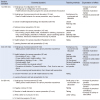Abstract
Purpose
This study was conducted to develop and evaluate the effects of a cancer prevention program for nursing students.
Methods
A nonequivalent control group pretest-posttest design was used. Participants were 53 nursing students (intervention group: 26, control group: 27). The cancer prevention program was provided for 3 weeks (3 sessions, 6 hours). Collected data were analyzed using SPSS/WIN 21.0 program.
Results
Compared with the control group, nursing students in the cancer prevention program group showed significant differences in perceived benefits (F=6.98, p=.001), perceived self-efficacy (F=16.00, p<.001), activity related affect (F=14.01, p<.001) and health behavior for cancer prevention (F=16.59, p<.001).
Figures and Tables
Table 1
Construction of Health Behavior Education Program for Cancer Prevention

Table 2
General Characteristics and Homogeneity of General Characteristics between Experimental and Control Group (N=53)

Table 3
Homogeneity of Dependent Variables between Experimental and Control Groups (N=53)

Table 4
Effect of Health Behavior Education Program for Cancer Prevention (N=53)

References
1. Lim MK. Cancer epidemiology and prevention. J Korean Oncol Nurs. 2008; 8(1):21–27.
2. National Cancer Information Center. Accessed February 15, 2016. http://www.cancer.go.kr/mbs/cancer/subview.jsp?id=cancer_010101010000.
3. World Health Organization. Accessed January 13, 2016. http://whqlibdoc.who.int/publications/2007/9241547111_eng.pdf.
4. Walker SN, Volkan K, Sechrist KR, Pender NJ. Health promoting life styles of older adults: comparisons with young and middle-aged adults, correlates and patterns. ANS Adv Nurs Sci. 1988; 11:76–90.
5. Kasl SV, Cobb S. Health behavior, illness behavior and sick role behavior. Arch Environ Health. 1966; 12(2):246–266.

6. Kim YS. Health behavior for cancer prevention and influencing factors in university students. J Korean Soc Sch Health Educ. 2012; 13(2):45–58.
7. Song MR, Park KA. An effect of the health education for health promotion on college students. J Korean Acad Soc Nurs Educ. 2001; 7(2):298–307.
8. Chung YH, Seo NS, Moon SH. Related factors in health promotion behavior by gender among collegy students. J Korean Soc Sch Health Educ. 2011; 12(2):29–42.
9. Kim BK, Jung MS, Han CH. Health promoting behavior of university students and related factors. Korean J Health Educ Promot. 2002; 19(1):59–85.
10. Hong H, Lee JS. Survey on korean food preference of college students in seoul-focused on the staple food and snack. Korean J Nutr. 2006; 39(7):699–706.
11. Kim JH, Kim SJ, Park YH. Factors influencing health promoting behavior of women college students. J Korean Acad Adult Nurs. 2001; 13(3):431–440.
12. Dinger MK, Waigandt A. Dietary intake and physical activity behaviors of male and female college students. Am J Health Promot. 1997; 11(5):360–362.

13. Hong SH. The relationship between perceived health status and health promoting behaviors among nursing students. J Korean Acad Soc Nurs Educ. 2013; 9(1):78–86.

14. Pender NJ. Health promotion in nursing practice. (3rd ed). Stamford, CT: Appleton & Lange;1996.
15. Kim HK. Factors influencing health promoting behaviors of university students using Pender's Model. Korean J Women Health Nurs. 2006; 12(2):132–141.

16. Kim HS, Oh EG, Hyong HK, Cho ES. A study on Factors influencing health promotion lifestyle in college students. J Korean Acad Community Health Nurs. 2008; 19(3):506–520.
17. Lee YN, Kwon IS. Factors influencing practices of health behavior for cancer prevention in university students. Asian Oncol Nurs. 2014; 14(2):109–118.

18. Park SM, Chung CW, Park MJ. Effects of small-group education for testicular self examination on knowledge, self-efficacy and performance intention in male college students. J Korean Acad Soc Nurs Educ. 2010; 16(2):292–300.

19. Yang YH. The effects of a BSE (breast self-examination) education program on knowledge self-efficacy and performance level in female nursing students. J Korean Acad Soc Nurs Educ. 2007; 13(2):277–283.
20. Kim HW. Effects of prevention education on human papillomavirus linked to cervix cancer for unmarried female university students. J Korean Acad Nurs. 2009; 39(4):490–498.

21. Cho MH, Kwon IS. Development and verification of the effect of health lifestyle education program for cancer prevention in late school-aged children. J Korean Acad Child Health Nurs. 2012; 18(4):192–200.

22. Faul F, Erdfelder E, Buchner A, Lang AG. Statistical power analyses using G*power 3.1: Tests for correlation and regression analyses. Behav Res Methods. 2009; 41(4):1149–1160.

23. Moon JS. A study of instrument development for health belief of korean adults [dissertation]. Seoul: Yonsei Univ.;1990.
24. Sherer M, Maddux J, Mercandante B, Prentice-Dunn S, Jacobs B, Rogers R. The self-efficacy scale: construction & vailidation. Psychol Rep. 1982; 51:663–671.
25. Oh HS. Health promoting behaviors and quality of life of korean women with arthritis [dissertation]. Austin: Texas Univ.;1993.
26. Yun SN, Kim JH. Health-promoting behaviors of the women workers at the manufacturing industry-based on the Pender's health promotion model-. Korean J Occup Health Nurs. 1999; 8(2):130–140.
27. Bandura A. Social foundations of thought and action: a social cognitive theory. Englewood Cliffs, New Jersey: Prentice-Hall;1986.
28. Pender NJ, Murdaugh CL, Parsons MA. Health promotion in nursing practice. (5th ed). Upper Saddle River, NJ: Person/Prentice Hall;2006.
29. Jo EJ. An analysis of the effectiveness of the K-WIFY model in participatory health promotion education for university students [dissertation]. Busan: Kosin Univ.;2004.
30. Ho SN. A study on the risk and protective factors influencing problem drinking behavior of university students [master's thesis]. Daejeon: Chungnam National Univ.;2014.




 PDF
PDF ePub
ePub Citation
Citation Print
Print



 XML Download
XML Download